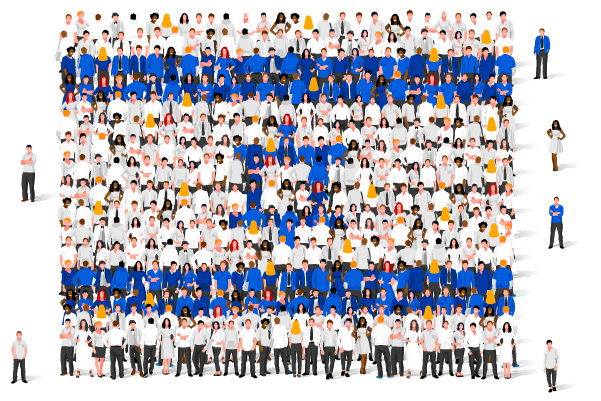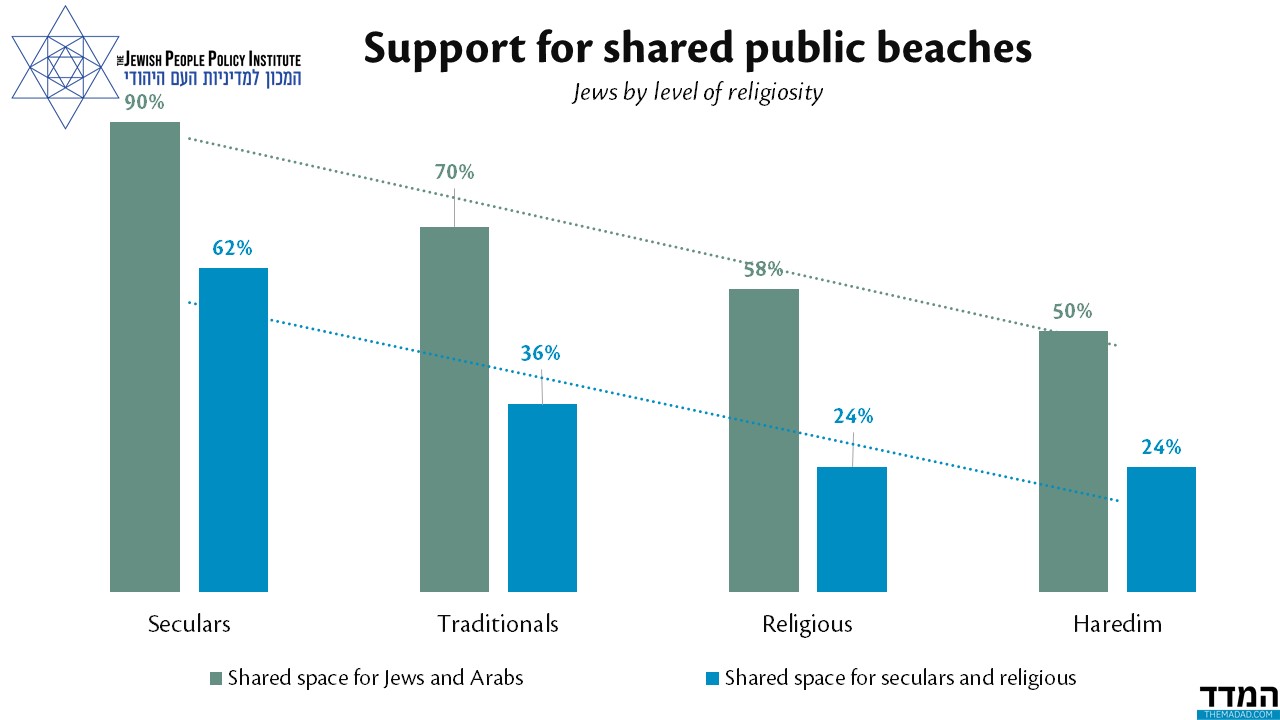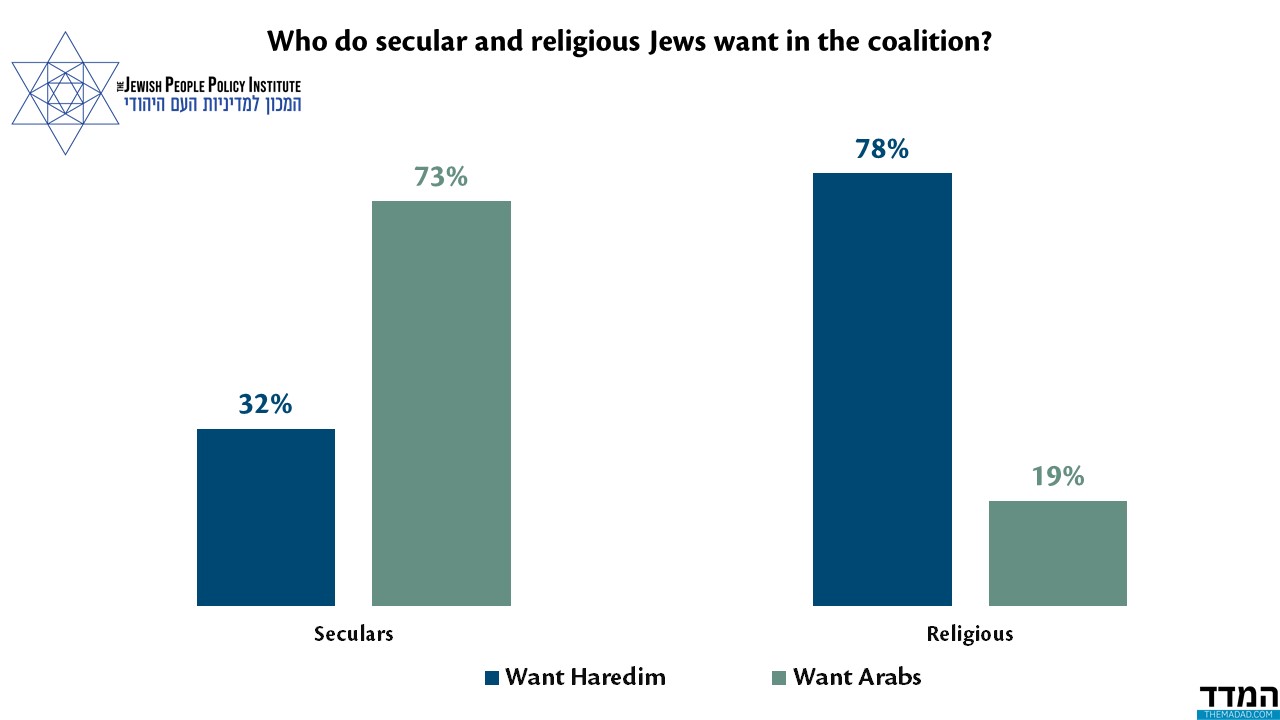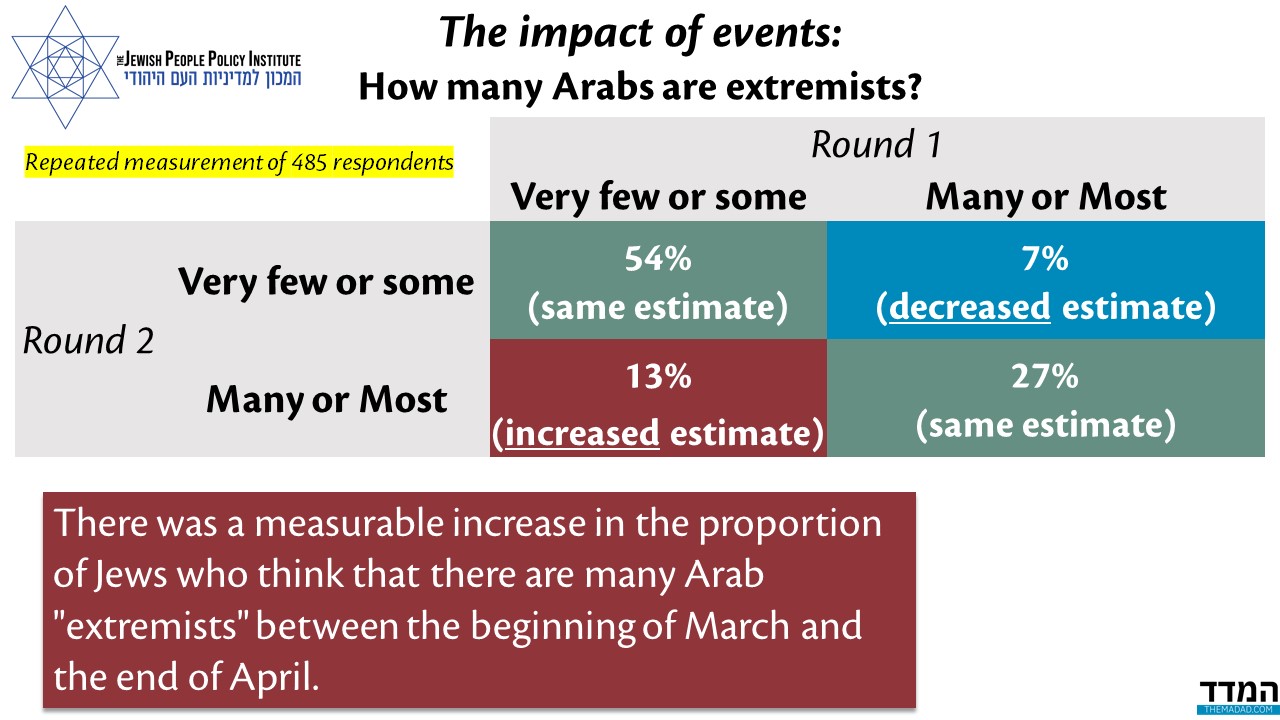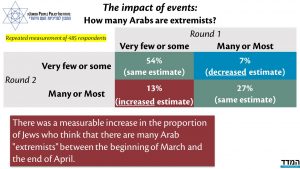The 2022 Pluralism Index
The survey that forms the basis of the Jewish People Policy Institute’s Pluralism Index was conducted this year when Israel and the world were (and still are) under the shadow of the Covid pandemic, and on the eve of the outbreak of war in Ukraine.
Below are a few of the significant findings of this year’s Index, followed by a detailed discussion of some of them:
Jewish-Arab relations
Responsibility for the plight of violence: Most Arabs blame Israeli state institutions for the high rate of crime and violence in Arab society – while most Jews blame Arab society itself.
Partnership between majority and minority: There is a double trend, both an increase in the proportion of Jews who consider Israeli Arabs to be desirable partners, and an increase in the proportion of Jews who object to such a partnership.
Image of extremism: The proportion of Jews who believe that many of the Arabs are “extremist” remains similar. There is an increase in the proportion of Arabs who believe that many Jews are extremists.
Presence in public spaces
Common areas of activity: Most Jews and Arabs in Israel agree that the majority of spaces used episodically, such as hospitals or supermarkets, should be shared by all.
Shared residential spaces: While the majority of Jews are interested in separate neighborhoods, without Arabs (two-thirds), most Arabs are interested in living in neighborhoods with Jews (with one-third supporting separation).
The desire for separation: Religious and Haredi Jews are more interested in separating spaces from Arab citizens than secular and traditional ones, including at beaches, swimming pools, IDF units, and universities.
Partnership and fraternity
The difficulty of reaching a broad consensus: Secular Jews aspire to political partnership with Arabs but not with Haredim; religious and Haredi Jews aspire to political partnership with secular Jews but not with Arabs.
What would be good to have: In principle, most Israelis think it would be good to have friends or acquaintances from other population groups; however, the Haredim and religious people object to friendship with Arabs.
The actual situation: At the practical level, most Israelis have friends or acquaintances from diverse social groups, including acquaintanceship between Jews and Arabs, and between secular and Haredim (but on a limited scale).
Jewish partnership: A large majority of Jews in Israel feel close to Diaspora Jews, but among the secular, a lower-than-average percentage sees a common future for Israel with Diaspora Jewry.
Israeli partnership: Among religious and Haredi Jews, a lower-than-average percentage sees a common future for Jews and Arabs in Israel; a relatively low proportion of them feels a special closeness to all Israelis.
Foreword
This is the eighth year that the Jewish People Policy Institute has published an annual Pluralism Index, and the seventh year that the Index is based, among other things, on a comprehensive survey of attitudes. As in previous years, the survey included Jewish and non-Jewish respondents. This year the survey in the Jewish sector was conducted for the first time through theMadad.com and included a relatively large number of respondents (more than 1,000). The Index has an established list of recurring topics in order to examine their development. The survey was conducted this year (as in previous years) by Prof. Camil Fuchs of Tel Aviv University. The analysis was written, in addition to Fuchs, by JPPI fellows Noah Slepkov and Shmuel Rosner.
Background conditions for the index
The survey underlying the Pluralism Index was conducted under certain social conditions, and against the background of developments that must be factored into the analysis. In the past year, it seems that the main development impacting the data is the new political situation in Israel, which has been led for about a year by a coalition of parties across the political spectrum, from right to left. This coalition does not include the Likud, which had been the ruling party for more than a decade, nor does it include the religious and Haredi parties (Religious Zionist, Shas, and United Torah Judaism). The coalition does include, for the first time in its history, an Arab-Islamic party (Ra’am). It relies on a tiny coalition majority, and enjoys limited public credit, with fierce criticism from its opponents. This state of affairs is also reflected in Pluralism Index data, which indicate a deep polarization in the attitude of various societal groups toward groups in the rival political camp.
Jewish-Arab partnership
More than one-fifth of Israeli citizens are Arabs. About one-eighth of Israel’s citizens are those who define themselves as “Haredim.” Together, these represent approximately a third of the total population – in other words, two groups whose numerical prominence means that they cannot be defined as small minority groups. Their political power, when exerted, is significant. Their ability to shape the social reality in Israel is also significant. Their power to present other groups in Israeli society with fundamental social and economic challenges can be seen in various situations, from the debate over the “Citizenship Law,” through the ongoing discussion on the nature of state-sanctioned conversion, through conflicts and challenges related to the Bedouin diaspora in the Negev, to the unresolved question of use of the Western Wall Plaza.
These challenges, and their impact on the attitudes of other groups in Israeli society toward Arabs and the Haredim, are reflected in almost every one of the Institute’s past surveys, and they have not been absent this year either. At the same time, against the background of the developments of the past year – which, in addition to the new political configuration, also include the violent events of May last year (mainly, but not only, in mixed cities), which highlighted the tension between Arabs and Jews – a process of change with two aspects can be identified in the data. On one hand, feelings of criticism, and even hostility, toward these groups among those who see them as political rivals; on the other hand, a calming of tensions among those who see the Haredim or the Arabs as political partners (or potential partners).
An example of this process can be identified by looking at a question asked both last year and this year in the same way. Do the respondents agree with the statement that Jews and Arabs have a “common future”? A general look at the answers of Jewish respondents shows that there has been no significant change in their responses. In both the 2021 and the 2022 surveys, the rate of those who answered “strongly agree” or “quite agree” with this statement was close to sixty percent (58%). However, a closer look reveals that within these two similar outcomes a significant change is concealed: it was achieved because in one group of Jews (who define their political position as “right wing”) there was a significant drop in agreement with the statement, while in another group of Jews (who define their political position as “left wing”) there was a substantial increase in agreement with this statement.
In other words, the overall percentage of Jews who agree that Jews and Arabs have a shared future remains the same, but while right-wing adherents, the majority of whom do not support a coalition that includes an Arab party, experienced an erosion of confidence in a shared future this year (whether as a result of the May disturbances, or because of the political context), left-wing adherents this year, most of whom support the coalition, experienced a process of strengthening trust in a shared future.
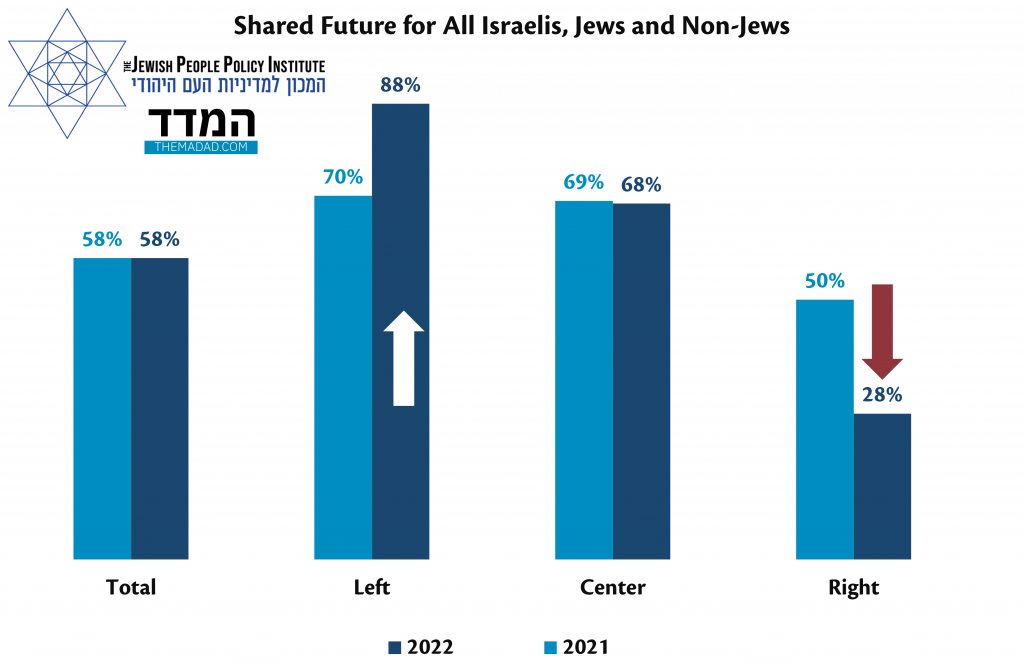
When examining another of the questions that appeared in a previous survey, asking Jewish respondents to estimate how many “extremists” there are among the Arabs in Israel (a parallel question asks Arab respondents to estimate how many “extremists” there are among Jews in Israel), a change can be identified in only one direction. Four years ago, only about a tenth of Jews estimated the number of extremist Arabs as “very few” (8%). This year, the percentage has doubled (19%), mostly among Jewish groups that define themselves as “secular” and politically positioned on the left. At the same time, there has been no significant change in the proportion of Jews who believe that there are “many” extremist Arabs. That is, here too we see a parallel process of rapprochement (of one sector of the population) and of distance (of another population sector), based on political stance. It should be emphasized that: 1. there is no question in the survey that enables us to know for certain that the political developments of the past year are the reason for this process; 2. in the 2018 survey there was a “don’t know” option that did not appear in the 2022 survey; and 3. the 2022 survey was conducted before a number of attacks were carried out by Israeli Arabs affiliated with ISIS at the end of March, which could have impacted the findings.

Among Arabs there is a significant decrease in the proportion of those who believe that only a few Jews are political extremists as compared with the 2018 data. This decrease is detectible in a parallel increase in the number of those who feel that “some” Jews are extremists, or that “many” are extremists. Several hypotheses can be posited regarding the reasons for this change, including the harsh rhetoric of four election campaigns, the Jewish public’s response to the May 2022 riots, and the fact that a significant portion of the Arab public does not support the participation of an Arab party in the governing coalition. It should also be noted that the survey was conducted at a time when there was ongoing debate in Israel about the “Citizenship Law,” which eventually passed in the Knesset with the support of most of the coalition parties and some of the opposition parties; in order to pass it, the coalition was forced to accept more uncompromising language than it had hoped.
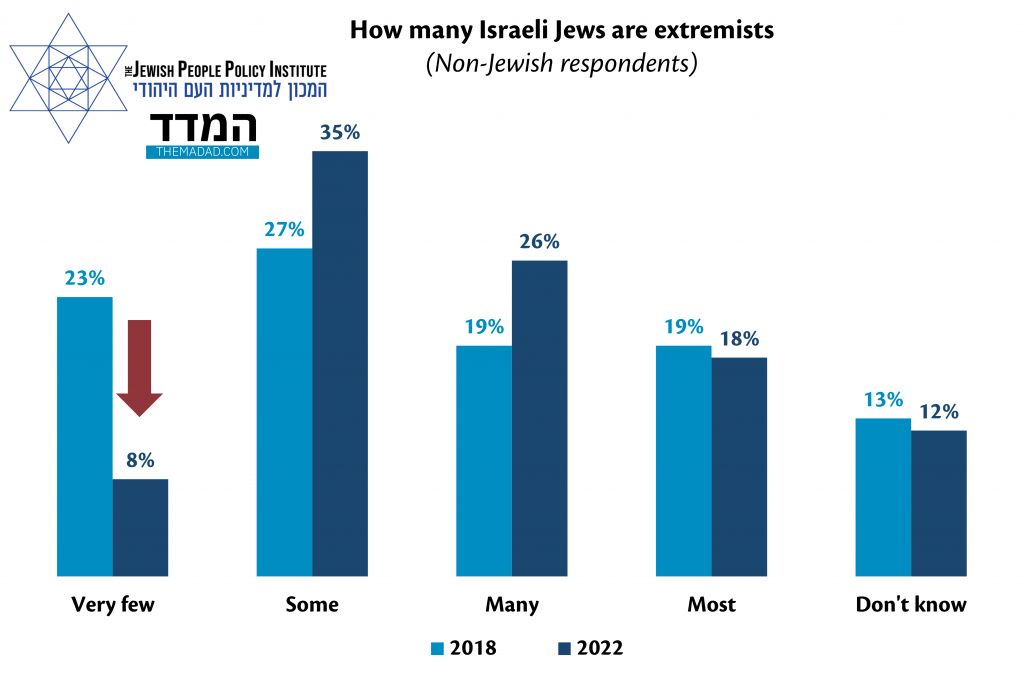
Violence in Arab society
Discussions about the level of violence in Arab society in Israel have been ongoing in the public arena for some time, gaining considerable traction at various times against the background of a violent outbreak, or attempts by the government to come up with ways to deal with the violence. In the first half of 2021 there was widespread preoccupation with an eruption that had a nationalist character, which affected Jewish-Arab relations in mixed cities and mixed neighborhoods.[i] In the second half of 2021, and at the beginning of 2022, the emphasis shifted to the state of internal violence in Arab society.[ii]
During the violence of May 2021, Jews in Israel were asked who they thought was responsible for the outbreak of violence, and were presented with six options for answering, some reflecting the responsibility of the establishment, or the Jewish majority, and others the responsibility of the rioters or the society from which they came.[iii] Most Jews argued in this case that the responsibility fell on the leadership of Arab society or the rioters themselves, but the police and the government also did not receive a high score from the survey respondents. In the pluralism survey, we similarly tried to examine the causes (in the opinion of the respondents) of the ongoing violence in Arab society, which has manifested in high rates of murder, robbery, collection of protection payments, and more. Respondents were asked to rate four options: two of them state that most of the responsibility for this phenomenon lies with the institutions of the state (government and police) that do not properly address the Arab sector, both in general terms (neglect) and in concrete aspects (the fight against violence). The other two reasons available to respondents, Jews and Arabs, focused on the internal characteristics of Arab society, and placed the responsibility on the “public” or, more generally, on the “culture” of Arab society.
This question sharply highlights the different views – contradictory to some degree – of Jews and Arabs on the social reality vis-à-vis Israel’s Arab citizens. While a majority of Jews (albeit a small one, 51%) see the internal factors of Arab society as key factors in the violence, a very significant majority of Arabs place the responsibility on the state (almost 80%).
Whereas the finger of blame among a large percentage of the Arab respondents is pointed at the government and the police, among the Jews, as expected, there is disagreement along political lines. The survey respondents were asked to rank the four reasons mentioned in order, and the rating varies according to political position. A very large majority (82%) of Jewish left-wing adherents consider state neglect as the number one cause of violence in the Arab sector. Adherents of the right, on the other hand, contend by a significant majority (61%) that the reason is “a question of culture in the Arab sector.” Broken down between internal and institutional reasons, the left is almost entirely focused on the failures of the establishment (92%), compared to the right, which places the blame on the Arab sector and its culture (77%) as the predominant factor (center party voters are divided about fifty-fifty).
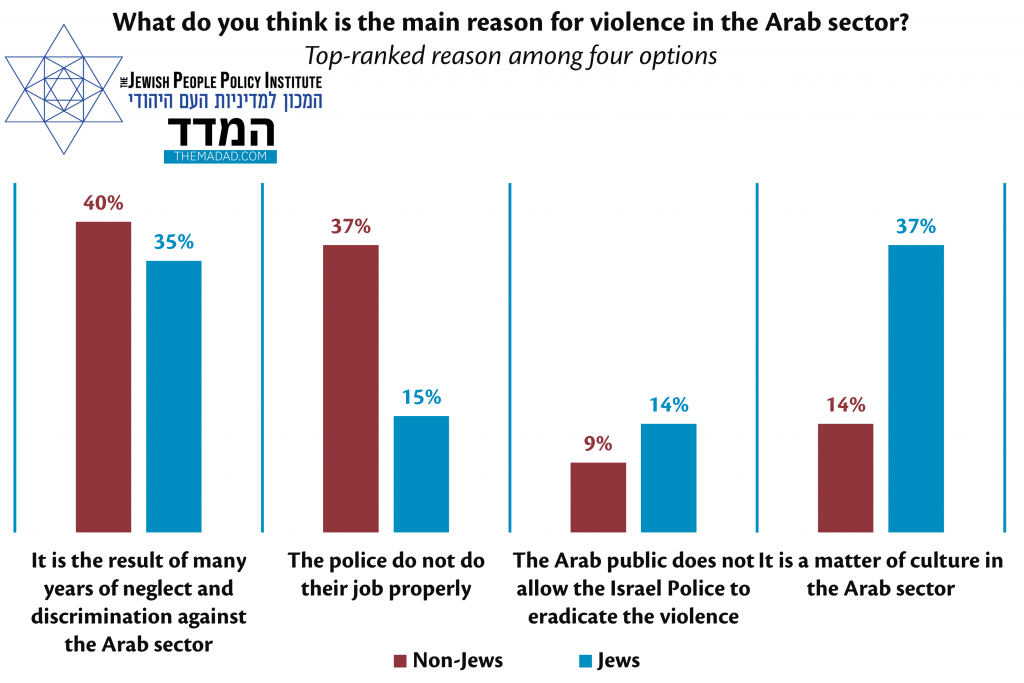
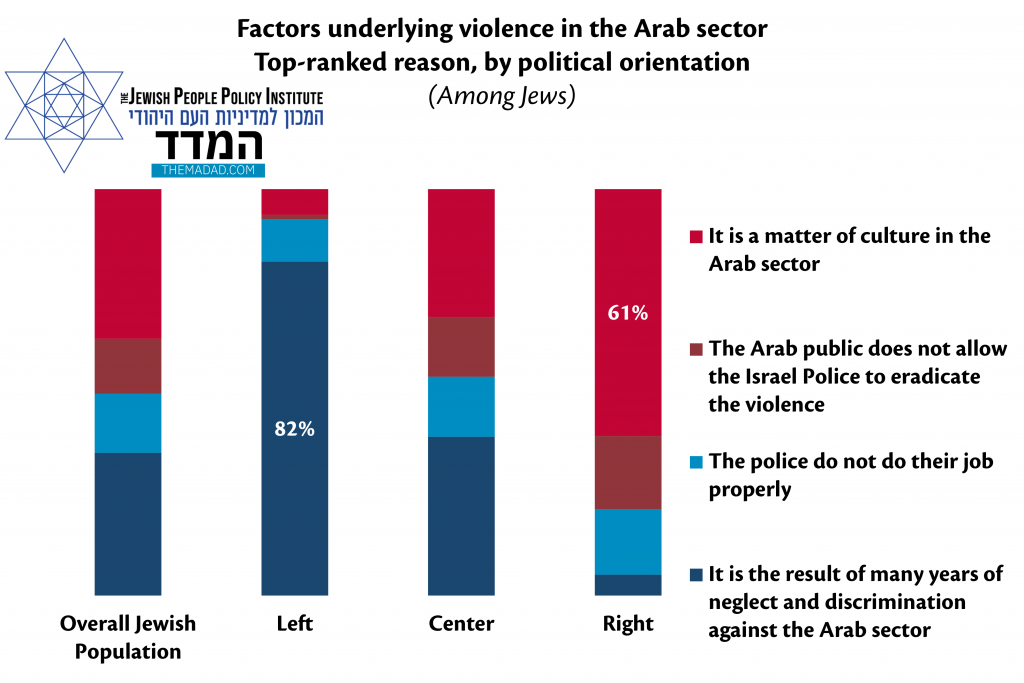
Partnership and friendship, in principle and in practice
As stated, we asked Jewish and Arab respondents – as we did last year – to respond to statements concerning “a shared future” and statements regarding “closeness” to various groups. Jews were asked about closeness to all Israelis, including Arabs, and about a shared future with all Israelis, including Arabs. They were also asked about closeness and a shared future with all Jews. We should note that this question was asked before the issue of aliyah (and with it the debate regarding the nature of the state’s Jewish identity) came to the fore in the wake of the war in Ukraine and the arrival of refugees, Jews and non-Jews, in Israel. For almost all of these questions no significant gaps were seen, on average, between last year’s findings and those of this year. A large majority of Jews feel a closeness with all Jews (some 70%), and a majority point to a shared future with all Jews (64%). A small majority feel a special closeness to all Israelis (53%, a certain increase compared with last year), and a greater majority feel a shared future with all Israelis (58%).
The issue of partnership was also examined this year through the political prism, in a question about the goal, in principle, of including different groups in the coalition. This question demonstrated that there are groups that almost the entire public wants to be part of the governing coalition (“secular” and “religious”), and other groups who draw many objections to their possible inclusion in the government (“Haredim” and “Arabs”). It also revealed an inverse correlation between the desire for a coalition that includes Haredim and the desire for a coalition that includes Arabs.
It shows that the higher up one is on the traditionalism scale (among Jews), the greater the desire for a coalition partnership with Haredim, and the lower the desire for a coalition partnership with the Arabs. Among the general public, around half are interested, in principle, in a coalition that includes Haredim (53%) and about half are interested, in principle, in a coalition that includes Arabs (52%). But those who desire one or the other of these options belong to different groups, as can be seen in the graph below.
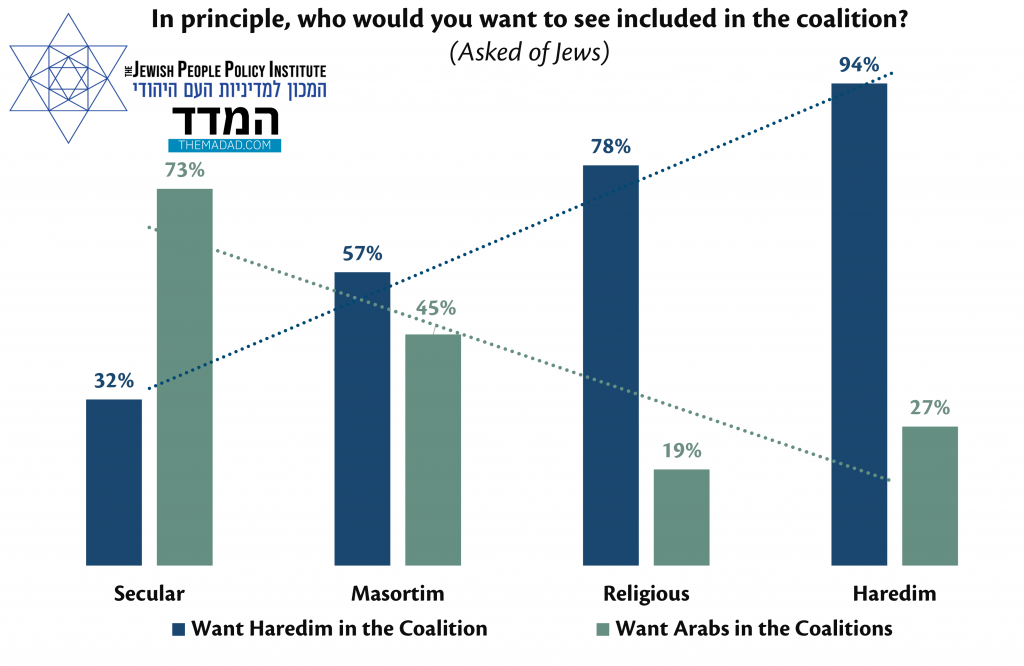
Similar gaps, though less acute, can also be seen in a question that does not relate to political partnership, but rather to the desire, in principle, for personal friendship. We examined, in broad terms, which groups Israeli Jews would be willing to connect with, in principle, on a personal level, and whether there are groups for which there is disapproval in regard to personal friendships. In general, it can be said that for the most part, that a considerable majority of Jews have no reservations about personal friendships with members of another group of Jews. There is a willingness (in principle), to connect with Jews from a group that is more or less religious, with Jews of a different ethnic community, and so on. However, most Haredi and religious Jews are reluctant to associate with Arabs.
When willingness in principle becomes a practical matter, that is, the question of whether Jews in Israel actually have friends or acquaintances from other groups, it turns out that there are groups that almost every Jew in Israel has acquaintance with (secular Jews), while there are groups with which such familiarity is lower. It should, of course, be noted that the size of the group is of critical significance in the context of whether Israelis know / connect with its members. For example, the population share of Ethiopian Jews in Israel is small, and therefore it is less surprising to learn that the rate of those who indicate that they have Ethiopian friends or acquaintances is lower (and the same is true for Druze). However, one should not ignore the fact that the low level of familiarity (and few friends) has an impact on the group’s social status, which can translate into alienation or suspicion. In fact, as we can see, the groups that have fewer friendships and acquaintances (Arabs and Haredim) are also the groups toward which there are reservations regarding political partnerships. Of course, this is also a feedback loop so it isn’t always clear what comes first: Does the small number of friendships make political partnership difficult, or do the political differences (and others, which we will soon discuss) make it harder to establish friendships and acquaintances?
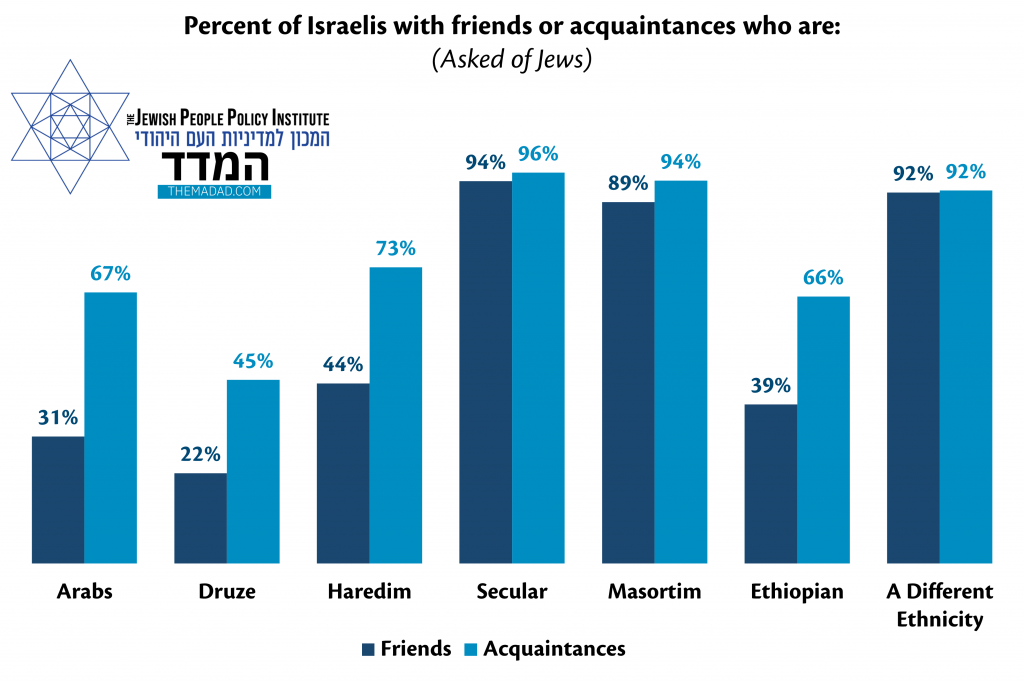
Shared and separate spaces
A key reason for the lack of friendship / acquaintance between different groups is the fact that Israel includes numerous spaces in which the homogenous population living there lacks significant encounters with other groups. This fact has already been discussed in several previous JPPI papers, mainly in the context of the separation of Jewish groups from each other. Thus, for example, earlier JPPI publications noted that almost all Haredim have mostly Haredi friends (89%),[iv] and that almost no Haredi wants to send their children to a mixed secular-religious school because such an education “may weaken faith and observance)” (63%), and because “each population needs its own specific education” (27%).[v] Prior JPPI surveys have found that about half of Haredim are interested in having Haredim and secular Jews live in mixed neighborhoods. It is worth noting that in regard to the question of residential space, these surveys found that the Haredim were the more tolerant group. Among secular Jews, a vast majority stated they did not want to live in the same neighborhood as Haredim (78% of those who defined themselves as totally secular).[vi]
Of course, the fact that the separation is perceived as desirable by citizens does not necessarily mean it is good for the state. Yishai Blank documented in detail how the state “is involved quite aggressively in residential patterns of secular and religious Jews” and how it uses a variety of tools to encourage
separation between different Jewish groups. Blank asserts that this is a misguided policy for several reasons – from jeopardizing the individual’s right to live anywhere he or she wants, to the fear of reinforcing stereotypes and systemic discrimination. Separation feeds “the growing enmity between Arabs and Jews, secular and Haredim, veteran Israelis and immigrants,” say Blank and Izzy Rosen Zvi.[vii] Some have taken the opposite view: that separation prevents friction, eliminates quarrels, and allows for a homogeneous life. “Most people want to live in an environment where they feel like they belong rather than feeling like strangers or feeling threatened,” wrote Ruth Gavison and Uri Schwartz about this issue, when presenting their position that favored, at least partially, the right of citizens to live separately.[viii]
This year’s survey also found that in certain cases separation into distinct neighborhoods is desirable for everyone. Just over a third of all Jews in Israel (38%) feel that city neighborhoods should be a “shared space for everyone, without separation.” Others believe it is better for there to be a separation in certain cases (42%) or always (19%). But this year, we did not focus specifically on neighborhoods, but sought to review a wide range of public spaces and the question of whether Israelis prefer them to be shared or separate – in two cross-sections. In the first section, we asked respondents whether separation between Jews and Arabs is desirable. In the second, we asked whether they wanted separation between secular and religious Jews. Overall, with respect to most spaces used by the public on an occasional basis, that is, intermittent visits for a specific purpose, there was broad agreement about shared spaces. This was the case for places such as hospitals, supermarkets, the beach, and to a lesser extent swimming pools. The desire for separation was evident, in the context of Jews and Arabs, with regard to cemeteries. The main gap between Jews and Arabs was seen in relation to neighborhoods. Among the Arabs in the sample, the majority stated that they prefer mixed residential neighborhoods; among the Jews, the majority of respondents preferred neighborhoods that were always or sometimes separate.

For questions regarding separation among Jews (secular, religious, Haredim) there was agreement that most areas should be kept as shared spaces, such as hospitals, public transport, universities, and supermarkets. There was wide agreement on the question of neighborhoods (the exception was among traditional Jews, who wanted to see more shared spaces than the other groups). But this was an inverse agreement – not on the need to connect but rather, on the need to remain separate (about 20%) or sometimes separate (around 40%); however, in total, a majority of some 60% felt that city neighborhoods should always include some separate spaces for secular, religious, and Haredi Jews.
It is worth noting that this question was a matter of principle, that is, it did not address the possibility that “you” would live in a shared neighborhood for secular and Haredim (or Arabs and Jews). Previous surveys have found that when posed as a practical question, the percentage of those wishing to live in homogeneous neighborhoods – with people who belong to the same national group (Jews) and those who keep a similar level of tradition practice – was much higher. In other words, many secular, religious, and Haredi Jews who say that, in principle, there could be some mixed neighborhoods and some separate neighborhoods, they would choose to live in separate neighborhoods.
In regard to some sites, we observed among religious and Haredi Jews a preference for segregation, which the secular and traditionalist Jews do not share. Thus, for example, most of the Haredim and almost half of the religious Jews want segregated swimming pools (among the religious there is a significant percentage who sometimes choose separation). This is compared with most secular Jews (although, not a large majority) who state that swimming pools should be integrated. A similar phenomenon is evident regarding beaches. Only a quarter of religious and Haredi Jews (24%) feel that beaches should be shared spaces.
There is a gap connected to processes that have been taking place in recent years related to the question of integration or segregation in armored divisions of the IDF. It can be assumed that this gap is the result of the rise of gender equality in the IDF and women’s entry into many roles including, in a few cases that have grabbed wide media attention, combat positions. Without entering the controversy over whether this change in the IDF is necessary or not, its impact is evident in the willingness of certain sectors to embrace partnership in military life. In examining the attitudes of secular and religious Jews, both sectors have high levels of military service (unlike the Haredim), we can understand that while a large majority of the secular (75%) see no reason to segregate secular soldiers and religious soldiers, almost half of the religious respondents want such separation always or in certain cases (47%). Especially relating to the second group, we can assume that those “certain cases” when separation is desirable are those where women might be present in the armored division (combat soldiers, and in some cases instructors).
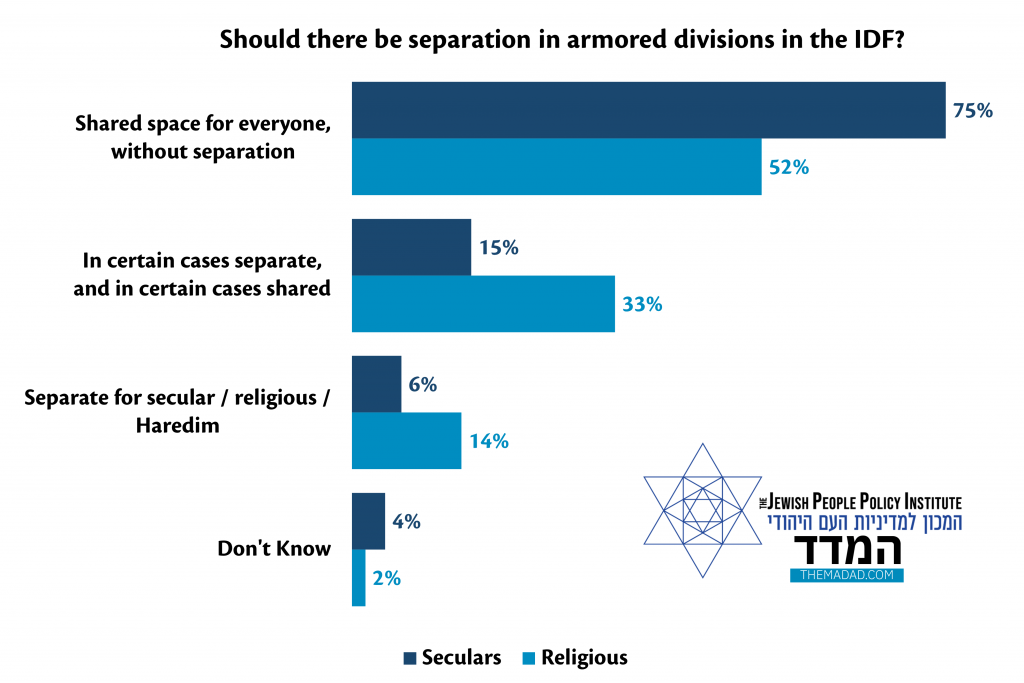
Who do you imagine as neighbors?
One of the more interesting questions that arises through the analysis of the study is what respondents imagine when they think of a “shared space.” When a secular respondent refers to a shared space with Haredim, do they imagine a Haredi man who averts his gaze at the sight of a woman on the street, or do they imagine a Haredi neighborhood in their city, which is an idea that has garnered much support among the Israeli public (as revealed in last year’s survey)? Does the Jew who is asked if they want to live among Arabs imagine living next door to the Arab doctor who treated him in a Haifa hospital, or does he imagine a mixed neighborhood in Akko (Acre) or Lod during a period rife with tensions between its residents, as we witnessed last year?
This question arose, among other things, in light of the very large gaps in the willingness of Jews affiliated with various ideological groups to reside in mixed neighborhoods alongside Arabs. Primarily, in light of the fact that among those who identify with the left, only a tiny percentage (2%) state that separate neighborhoods are desirable, while in contrast, a very large majority (70%) prefer shared neighborhoods. Naturally, this position – as a matter of principle – is fundamentally different from the actual situation presently found in Israel. Left-wing voters, who generally belong to groups with relatively high incomes, rarely live in neighborhoods shared by Arabs and Jews. Therefore, when we consider their position, there are actually three options:
First, to understand this position as a matter of principle, which has no practical application whatsoever and is, therefore, easily expressed.
Second, to understand this position as less than fully authentic, given the distinct gap between what is stated and what is practiced.
Third, to assume that the respondents understand the question in a particular way that allows them to respond to it without noticing the tremendous gap between the position in principle and the practical position.
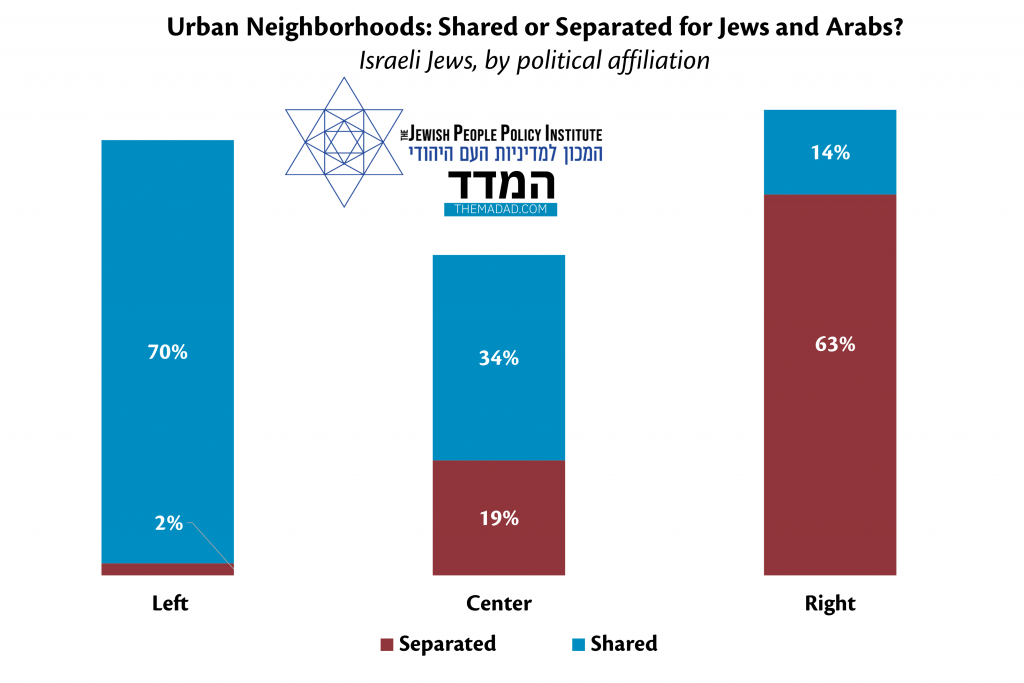
This third option led us to examine the question of “imagined neighbors” and to conduct additional research. In practice, after the initial survey was completed, we changed the wording of the question concerning space shared by Jews and Arabs and looked at how an additional respondent sample answered the revised version. In this new version two similar changes were made. First, in the introductory remarks, we emphasized the possibility that the question deals with Jews and Arabs “with similar incomes and educational backgrounds.” In so doing we attempted to influence how the interviewees image the neighbors we were asking about. Accordingly, in the response choices, we gave two options for a single shared residential space. The first was “shared by any Jews and Arabs,” and the second was “shared by Jews and Arabs with similar backgrounds.”
Responses to the revised version were collected for an additional two weeks, in order to see if there was a genuine difference in the answers between the version that leaves room for the respondents to decide for themselves who the “Arabs” being referred to are, and the version that enables respondents to adjust their answer to Arabs who are “like them” in certain respects (but different to the extent that they are Arabs, and the respondents are Jews). The new data did not reveal significant differences in responses.
Technical data
JPPI’s Pluralism Index Survey is one of the products of the Pluralism Project initiated by the William Davidson Foundation. The 2022 survey was conducted by Prof. Camil Fuchs of Tel Aviv University. It included approximately 1100 respondents in the Jewish sector, and another 200 respondents in the non-Jewish sector through a combined online and telephone survey. The respondents constitute a representative sample of the two populations surveyed. The survey in the Jewish sector was conducted by theMadad.com; sampling error 4% at a significance level of 95%. In the non-Jewish sector, the survey was conducted by Afkar. Sampling error 9.7%.
[i] See: “The 2021 Riots” by Israeli Arabs and their implications, Shmuel Rosner, Jewish People Policy Institute, June 2021.
[ii] A discussion of this phenomenon can be found in the reports of the Samuel Neaman Institute, the Executive Committee for Dealing with Crime in Arab Society, the Abraham Initiatives, the Institute for Zionist Strategies, the Institute for National Security Studies, and the State Comptroller’s reports. See: Why is the police having difficulty in eradicating crime in [Arab] society, Shmuel Rosner, Maariv, September 2021.
[iii] See: Who is to blame for the situation? The Arabs and the police (at least, so the Jews think) …, theMadad.com, May 2021.
[iv] Pew Israel, 2015. Secular Jews also have mainly secular friends (90%). For traditional and religious Jews there is a higher percentage of friends from other groups.
[v] From the Pluralism Index, Jewish People Policy Institute, 2018. Additional data on shared residence in the following paragraphs are taken from the 2017 Pluralism Index.
[vi] A discussion of this issue appears in the book, “Israeli Judaism: A Portrait of a Cultural Revolution,” published by JPPI in cooperation with Devir Publishing. Shmuel Rosner and Camil Fuchs, 2018, pp. 1445-145.
[vii] “Municipalities Bill: A Present Without a Past, Reform Without a Future.” Yishai Blank and Izzy Rosen Zvi. Laws Vol. 1 (2009), 49.
[viii] Residential separation as a component of discrimination: The American experience. Ruth Gavison, Uri Schwartz. Law Studies XXV, 2001.

